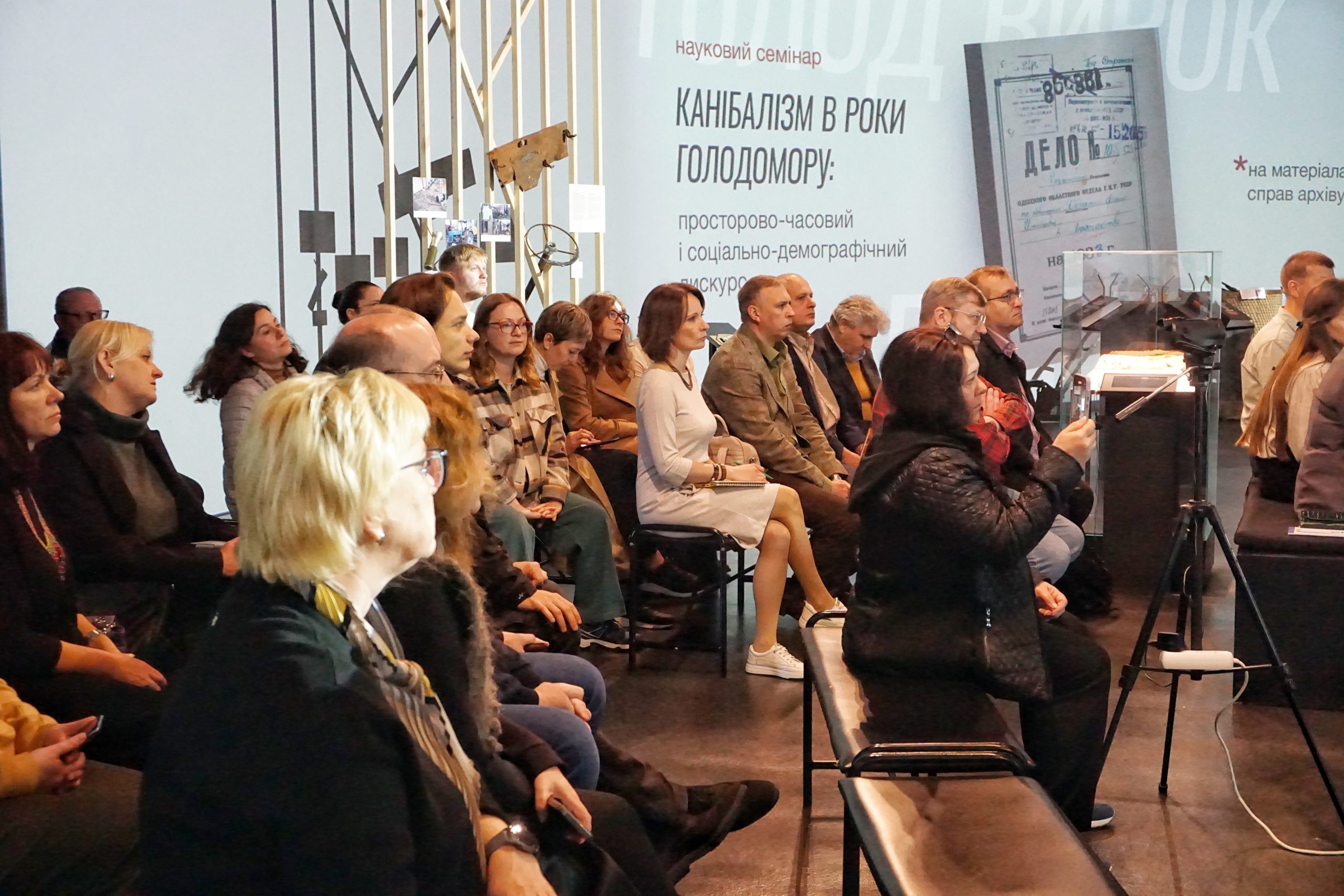The first results of the investigation of criminal cases on cannibalism during the Holodomor period are presented
On 7 May, the Holodomor Museum hosted a scientific seminar “Cannibalism during the Holodomor: Spatial-Temporal and Socio-Demographic Discourse (Based on Criminal Cases from the Archives of the Ministry of Internal Affairs of Ukraine).” During the event, museum researcher Roman Tesliuk presented the first interim results of a study based on criminal cases of cannibalism and corpse-eating committed during the Holodomor.
“This meeting would not have happened if it were not for the long-term strong and partnership cooperation with the Ministry of Internal Affairs of Ukraine, with which a Memorandum was signed in due time, said Lesia Hasydzhak, Director General of the National Museum of the Holodomor Genocide, in her welcoming speech. As a result of this cooperation, in 2023, the Ministry of Internal Affairs archive opened its doors to museum staff, and, in a brief time, 1022 criminal cases of the Holodomor years on the fact of cannibalism were digitised.”
These documents had been stored in the Sectoral State Archives of the Ministry of Internal Affairs under the ‘top secret’ classification for a long time. The unique documents had been classified by the communist regime because they contained evidence of the deliberate and carefully planned destruction of the Ukrainian nation.
“In these cases, we can learn the stories of literate, once wealthy Ukrainians who were brutally murdered. Cannibalism is a terrible phenomenon that our hearts did not allow us to see, because the very fact of cannibalism is horrible for human perception,” said Inna Yashchuk, State Secretary of the Ministry of Internal Affairs of Ukraine, “And so every time we got acquainted with individual cases, on the one hand, my colleagues and I did not let go of the stories of families who were driven to such a crime. On the other hand, there was a fear that there would be people who could falsify and present the history of our ancestors from a different perspective. But today we have open cases because those who are Ukrainians want to know the truth and can read the documents correctly. And to see how people were driven to corpse-eating and cannibalism.”
Since November 2024, electronic copies of criminal cases have been published on the Ministry of Internal Affairs of Ukraine’s website in the section “The Holodomor of 1932-1933 in Ukraine: in the language of archival documents.”
The source base for Roman Tesliuk’s research was 1,021 cases (since one of the digitised cases did not involve cannibalism), as well as 1,019 criminal cases that were destroyed in 1956. However, there was data on the names of the accused, their age, place of birth, and the sector of the DPU that handled the case. This information was used by our researcher.
While studying the cases, Roman Tesliuk analysed the region, age, gender, marital status, social status of the accused, as well as the period in which the crimes were committed and the sentences handed down in the cases. According to the researcher, most criminal cases were registered in the Kyiv region, which at the time also included part of the present-day Cherkasy and Zhytomyr regions – 836, and the largest number of defendants was recorded here – 1304. Most of the accused were women (69% vs. 31%). By age, they were mainly 17-50 years old. In terms of marital status, the women defendants were mostly widows, single, and divorced, while the men were predominantly married. The majority of the defendants in the criminal cases were collective farmers (55%), which once again proves that those who joined the collective farms were just as desperate victims of the regime as those who did not. The timing of the incidents is significant: with a few exceptions, nearly all documented cases of cannibalism occurred in 1933, specifically between February and September, when the death toll from starvation reached its peak. However, the first cases began to be reported as early as 1932.
“The Holodomor caused enormous quantitative losses of population and profound deformations of Ukrainian society. Prolonged starvation provoked significant changes in the psyche of people. The Convention on the Prevention and Punishment of the Crime of Genocide stipulates that causing serious bodily or mental harm to members of a group and deliberately creating living conditions for members of a group that are calculated to bring about the group’s destruction in whole or in part constitutes the crime of genocide. And the phenomena of cannibalism and corpse-eating during the Holodomor are direct evidence of the Kremlin’s totalitarian regime’s criminal intent to genocide Ukrainians,” Roman Tesliuk emphasises.
Our staff will continue to research these criminal cases, and the results will be published in specialised publications. The Ministry of Internal Affairs also states that work is underway to further digitise criminal cases from the Holodomor period. In particular, this includes cases related to individuals accused under the 5 Ears of Grain Law and those involved in resistance actions. The array of this information will be made publicly available soon.
